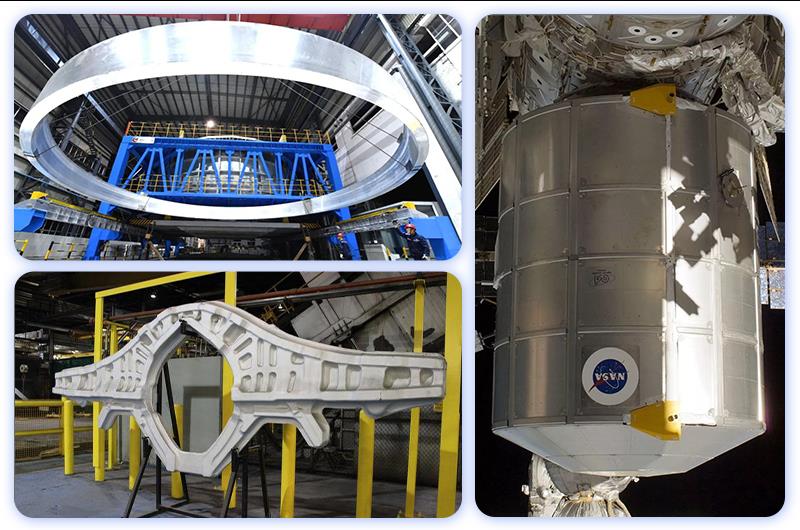The main gap between Chinese
aerospace aluminum alloy and foreign one is as below:
There is an obvious gap between China and the developed countries in Europe and America in the R & D and application of
aerospace aluminum alloy. In terms of alloy research and development, China only began to research 7075, 2024, 7175, 7475, 7050, 2124, 2224, 2324 and other aluminum alloys in the mid-1980s. However, there is still a big gap between the performance, variety, specification and state of the materials and the level of the United States. Since 1990, China has carried out research on 7A55, 6A60, high damping aluminum alloy, heat-resistant aluminum alloy and Al Li alloy. Except that the latter is used to manufacture the cabin structure of Tiangong-1 resource module, the research on other alloys is still immature.

In terms of aluminum alloy application, American high-purity 7175, 7475, 7050, 2124, 2224 aluminum alloys have been widely used in F-15, F-16, f / A-18 and other series aircraft. The structure of the fourth generation fighter f / A-22 is also made of 2524-t3, 7150-t77, 7055-t77 aluminum alloys. 2197 - t861 aluminum alloys have been used to manufacture the structural parts of B777, C-17, F-35 and other aircraft. China's aviation industry is still using 7A04, 2A12 and
7a09-t73, 7a09-t74 and other aluminum alloys.
The reason for the gap are as below:
There are many reasons for the lag of
aerospace aluminum alloy in China, mainly including: (1) the lag and lack of basic theory and process research. Without basic theory and technical research, there will be no innovation. Looking back on the development history of aluminum alloys in the world, it can be clearly seen that without the discovery of age hardening phenomenon and the in-depth theoretical research on it, the first generation of high static strength aluminum alloys will not appear; Without the invention of over aging system, there would be no second generation of high corrosion resistant aluminum alloy; Without a systematic study of the influence of impurity elements of aluminum alloy, especially Fe and Si, on the properties of the alloy, the formation of the third generation high-purity alloy and the rapid improvement of its production process will not be possible; Without the invention of precision solid solution treatment and multi-stage aging technology, the optimization of alloy main components, and the improvement of precision control technology and equipment, the current era of high-performance aluminum alloy will not come, nor will it be able to meet the severe challenges of titanium alloy and composite materials, and only part of the market will be let out.

(2) Laboratory research results are not converted into productivity in time or slowly. Although we have done a lot of research on foreign advanced aluminum alloys and made considerable achievements, most of them are in the laboratory stage, and the work of transforming them into large-scale production is slow. The research process level of 7475, 7050, 2124, 2224, 2324 and other aluminum alloys developed in China in the 1990s is much higher than that of industrial batch production. However, many problems encountered in the experimental production are difficult to solve, which greatly hinders the application of the alloys. The research on the application technology of some new aluminum alloys is not enough, and the leading trial assessment of new materials is not enough, which has caused great difficulties and great risks to aircraft material selection.
(3) no complete aviation material system has been established. On the one hand,
aerospace aluminum alloy in China is in a state of many brands, incomplete material varieties and specifications, and incomplete material data. On the other hand, the urgently needed high-performance aluminum alloy materials cannot be produced and provided, and China's aviation material system and material standard system have not been formed. Both Alcoa and kenlian aluminum have their own independent aerospace material systems, and the aluminum materials provided can meet the requirements of American aerospace standards and European aerospace standards. At the same time, they work closely with Boeing aircraft company and Airbus to provide aluminum materials needed for the manufacture of new aircraft in a timely manner.

(4) material production equipment needs to be further improved. In recent years, China's equipment for producing aerospace aluminum materials has greatly improved, and some of them are still at the world's leading level. For example, it has built a professional production line for
aerospace aluminum alloy thick plates, introduced a number of advanced roller bottom solid solution treatment furnaces and water immersion ultrasonic flaw detection production lines for thick plates, and some enterprises, such as the melting and casting workshop of Northeast Light Alloy Co., Ltd., have made major technological transformation, So as to adapt to the casting of 7075, 7055 and other aluminum alloy large-size flat ingots. However, the equipment for producing aviation extruded materials should also be further improved and reformed. Much has been done on the basic principle and laboratory work of T77 state, but the process equipment for realizing industrial batch aging needs to be built.







